Key takeaways:
- Pro-life advocacy emphasizes the intrinsic value of all human life and the importance of protecting the vulnerable, including unborn children and marginalized individuals.
- Community surveys play a crucial role in understanding the needs of the pro-life movement, driving initiatives that address holistic issues, such as healthcare access and emotional support for mothers.
- Effective survey design focuses on clarity, simplicity, and anonymity to encourage honest feedback, which leads to actionable insights that better inform advocacy strategies.
- Engaging the community through discussions and digital platforms enhances dialogue and connection, while collaboration with other organizations can amplify advocacy efforts and foster unity.
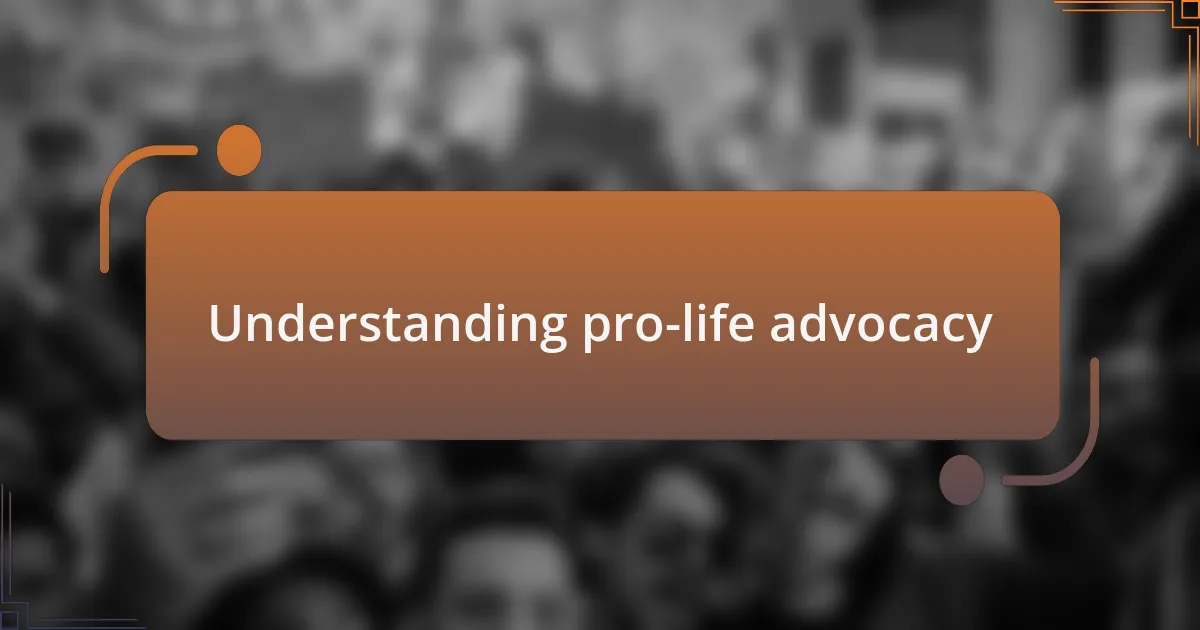
Understanding pro-life advocacy
Pro-life advocacy is rooted in the belief that every human life holds intrinsic value, from conception until natural death. I remember attending a local rally where the sheer passion of the crowd left an imprint on me. It struck me—how could we, as a society, debate the worth of life itself?
At its core, this movement seeks to protect the most vulnerable among us and not just unborn children but also those who are marginalized. Have you ever thought about who gets to speak for those who can’t speak for themselves? I have, and it often evokes a deep sense of responsibility within me to ensure that their voices are heard.
Understanding pro-life advocacy also means recognizing the diverse perspectives within the movement. My conversations with friends who see this issue differently often unveil emotional layers and complexities, reminding me that while we stand on firm beliefs, empathy plays a crucial role in fostering dialogue. How can we bridge these divides while remaining true to our convictions? It’s a delicate balance, and it’s worth exploring together.
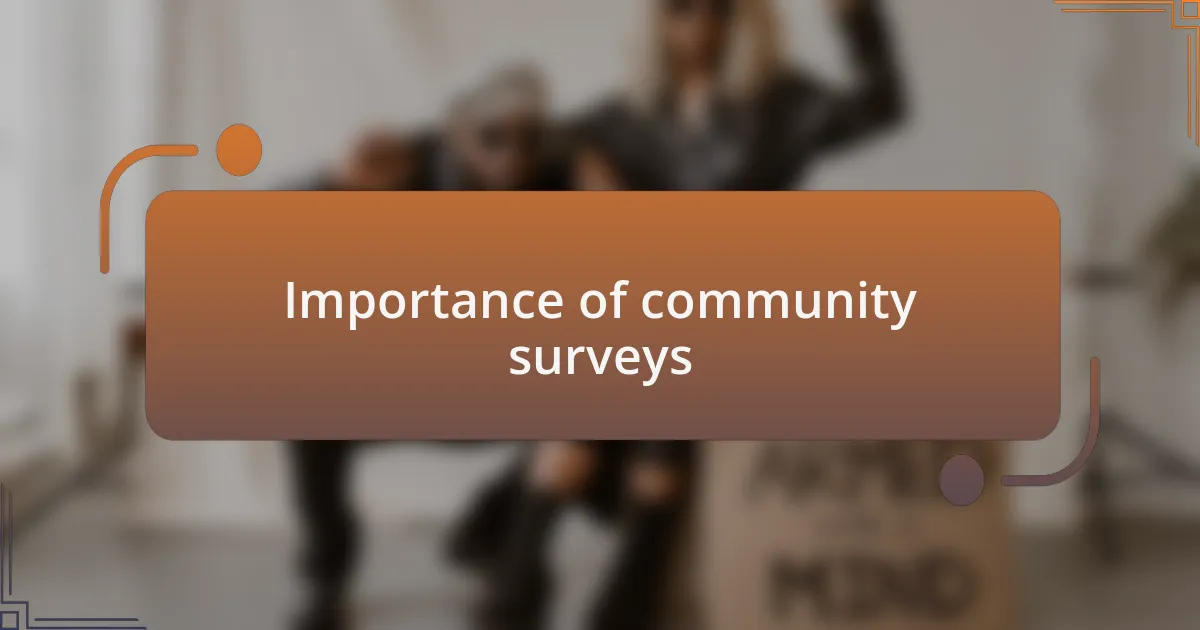
Importance of community surveys
Community surveys are essential tools for gauging the sentiments and concerns of individuals within the pro-life movement. I recall one survey we conducted; the responses highlighted not only support for protecting unborn life but also concerns about healthcare access for mothers. It was a pivotal moment for us, revealing that advocacy spans beyond mere messaging—it’s about understanding the holistic needs of our community.
Moreover, these surveys can shape our approaches and strategies, ensuring that we address relevant issues directly. I often reflect on how we, as advocates, might assume we know our audience, but the data often tells a different story. When we listen, we unlock opportunities for deeper engagement and targeted outreach, paving the way for more meaningful dialogues.
Finally, community surveys can create a sense of belonging among supporters. I experienced this firsthand when a survey highlighted the importance of support systems for pregnant women. It encouraged our group to organize workshops and support networks, ultimately fostering a stronger, more connected community. Isn’t it empowering to witness how such simple tools can drive impactful change?
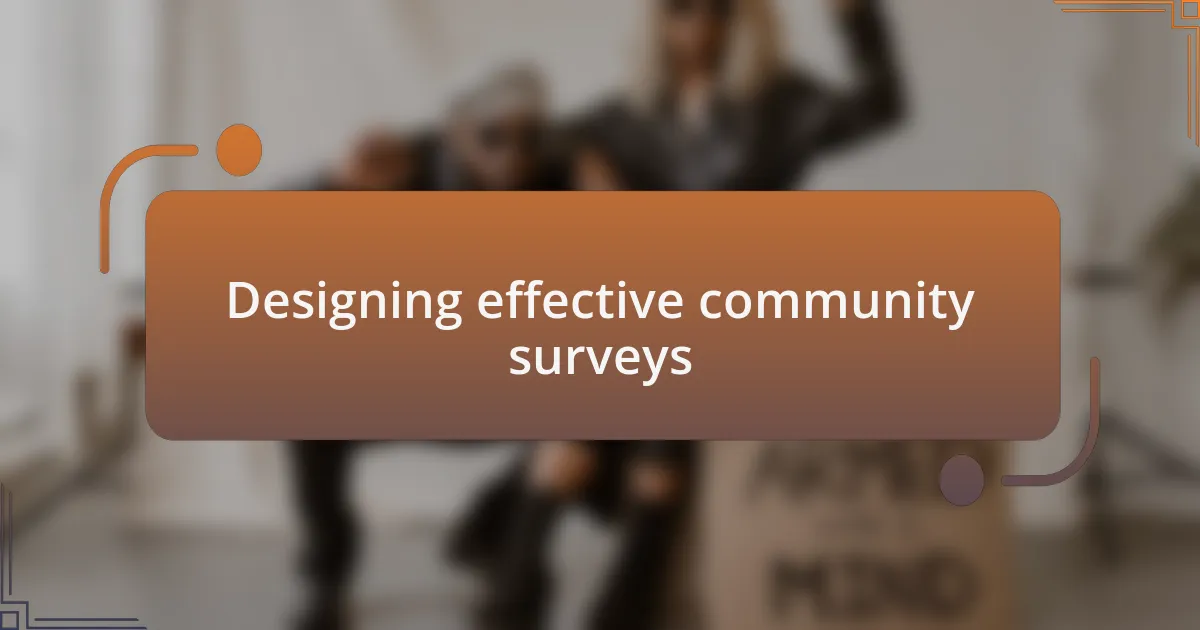
Designing effective community surveys
When designing effective community surveys, clarity is paramount. I always start by identifying the specific goals of the survey. For instance, I once focused a survey specifically on the health and emotional needs of expectant mothers. That clearly defined objective helped streamline our questions and made the responses far more actionable. Have you ever noticed how sometimes vague questions yield vague answers? Pinpointing our purpose creates a roadmap for insightful feedback.
In crafting the actual questions, I’ve learned that simplicity is key. During a past survey, I experimented with open-ended questions, inviting participants to share their personal stories and experiences. The emotional depth of those responses was eye-opening, revealing facets of advocacy I hadn’t even considered. This experience taught me that engagement often flourishes when people feel their voices truly matter.
Furthermore, I always emphasize the importance of anonymity, as it encourages honest feedback. In one case, when we ensured respondents could remain anonymous, the frankness of the responses surprised me. It’s a reminder that vulnerability can sometimes lead to the most valuable insights. Have you ever felt hesitant to share your thoughts in a public setting? That’s why creating a safe space to express opinions in surveys can elicit richer, more genuine responses that guide our advocacy efforts effectively.

Analyzing survey results
When I dive into analyzing survey results, I find it incredibly rewarding to see how numbers translate into real stories and needs. For example, when we compiled data from a recent survey on women’s perspectives surrounding pregnancy options, the statistics were just the beginning. Each percentage represented a voice, sometimes revealing surprising trends that I hadn’t anticipated—like how many participants expressed a desire for more emotional support during their pregnancies.
Sorting through responses, I often look for themes that emerge from individual anecdotes. It’s fascinating to see how certain concerns, such as financial stability or fear of judgment, resonate across many participants. I remember a particular instance when one respondent’s poignant story about her struggles struck a chord with our entire team. It served as a reminder of the stories behind the data, urging us to adjust our advocacy strategies to address these heartfelt concerns more effectively.
As I reflect on the insights gained, I can’t help but wonder: how can we convert these findings into tangible action? After analyzing the data, I prioritize creating actionable steps that directly address the needs identified. This isn’t just about crunching numbers; it’s about fostering a deeper connection with the community’s true desires, which ultimately shapes our advocacy efforts for the better.
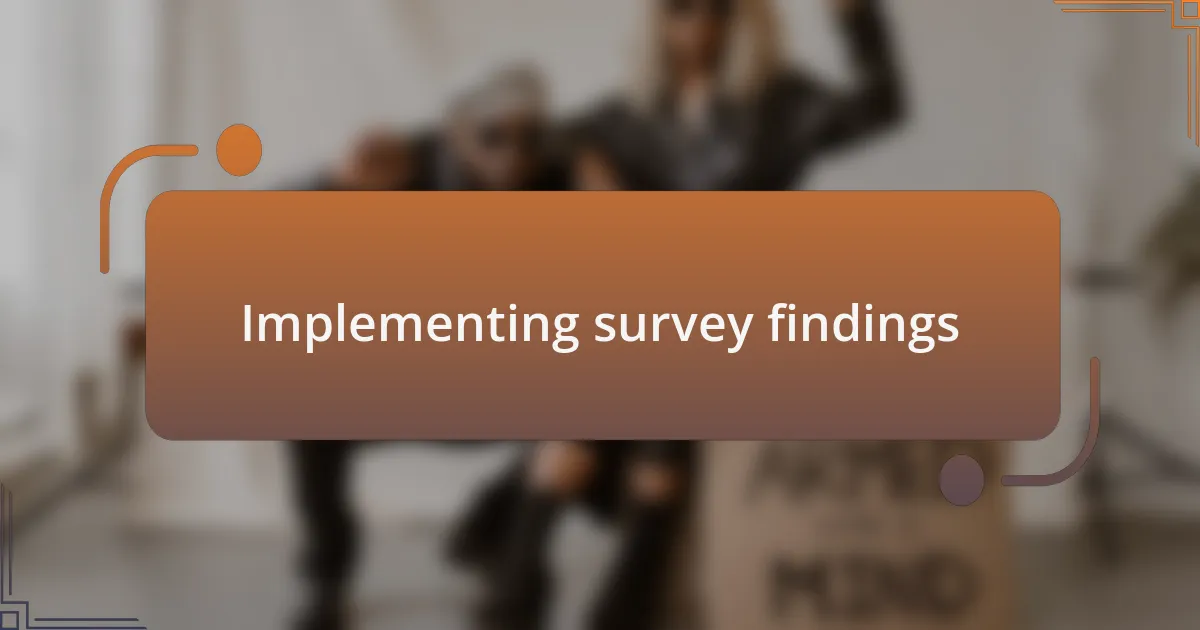
Implementing survey findings
Once the survey findings are clear, I focus on implementing changes that resonate with what our community genuinely needs. For instance, after discovering that a significant number of respondents felt isolated during pregnancy, we initiated a mentorship program that pairs experienced mothers with those who are expecting for the first time. It’s rewarding to see how a simple connection can alleviate feelings of loneliness—every shared experience builds a stronger support network.
In another instance, a particularly striking statistic revealed that 75% of participants wished for more information about available resources. This prompted me to create a comprehensive resource guide, integrating local services and emotional support hotlines. I still remember the enthusiasm at our launch event when someone spoke about how this guide had opened doors for them during a daunting time. Hearing her express gratitude made all the hard work worth it and reminded me of the profound impact we can have.
As I consider our next steps, I often ask myself: how can we continue engaging our community? I believe it’s essential to keep the conversation going. Hosting regular town halls has been a game changer, allowing us to gather continuous feedback and adapt our initiatives accordingly. The discussions that unfold are filled with raw emotion and real-life experiences, reinforcing the idea that our advocacy must be a living, breathing dialogue that evolves with our community’s needs.
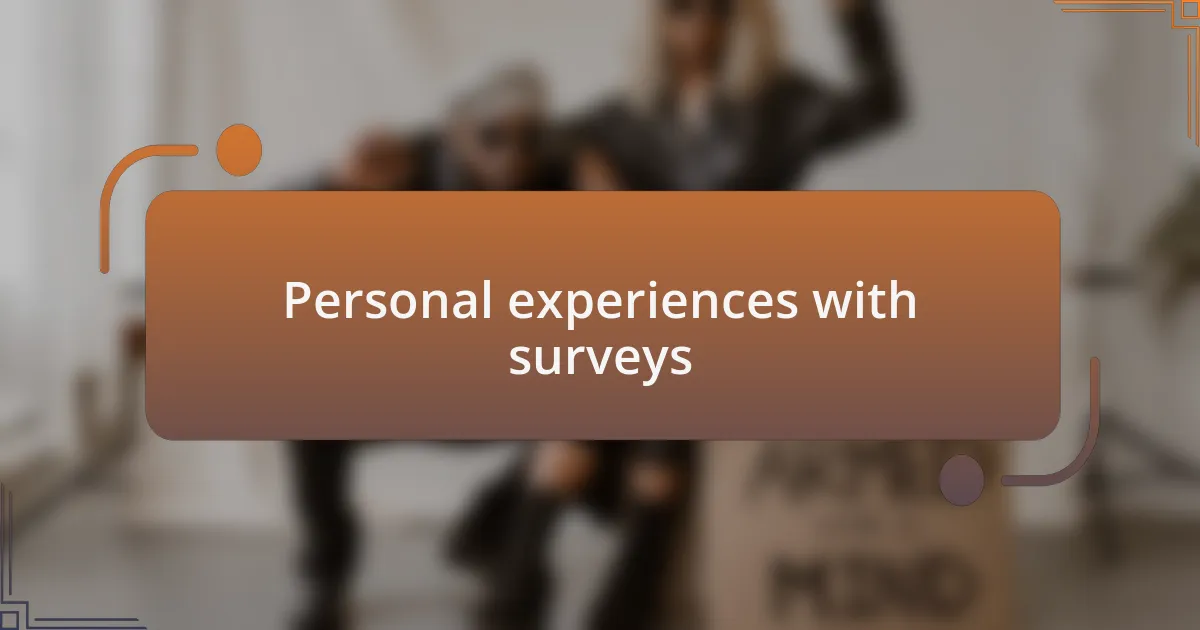
Personal experiences with surveys
When I first started utilizing community surveys, I was amazed at how candidly people shared their experiences. One survey revealed that several participants felt misunderstood in their pro-life journey. Their heartfelt responses reminded me of how, in the early days of my advocacy, I too struggled to voice my thoughts and feelings. It made me wonder—who else might feel the same way but hasn’t spoken up yet?
During a recent survey, one mother shared a story that truly struck a chord with me; she recounted moments of doubt and fear during her pregnancy, yet expressed gratitude for our community’s support. I can still picture her tearful smile as she described how knowing others cared made a world of difference. This type of raw honesty is why I advocate for continuous feedback—it’s not just about gathering data; it’s about creating a safe space for sharing and healing together.
Reflecting on my experience with surveys, I realized they serve a dual purpose. Not only do they provide valuable insights, but they also foster a sense of belonging within our community. I often catch myself thinking, what if we could amplify these voices further? Each survey response acts like a thread in the fabric of our movement, and weaving these threads together strengthens our collective narrative.
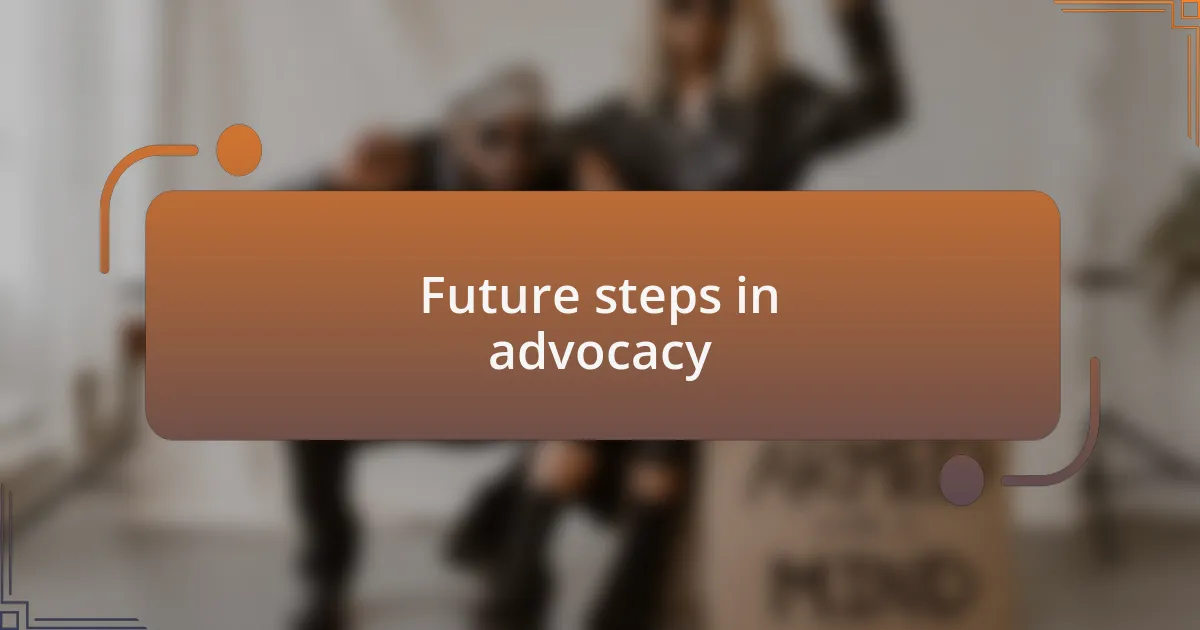
Future steps in advocacy
As I look toward future steps in advocacy, I believe it’s vital to deepen our engagement with the community. For instance, I once organized a small gathering to discuss the survey findings with participants. The connection felt electric as we exchanged stories, and it struck me that real-life dialogues breathe life into data, transforming bullet points into personal narratives. How often do we miss the opportunity to turn surveys into meaningful conversations?
In addition to hosting discussions, I think we should explore more digital platforms to reach a wider audience. I remember experimenting with a series of online webinars after gathering survey insights—this move opened doors for individuals who might never attend a physical meeting. By creating accessible forums for dialogue, we elevate voices that could remain unheard. Isn’t it fascinating how technology can dissolve barriers and create a supportive environment for dialogue?
Moreover, we would benefit from collaborating with other organizations dedicated to similar causes. I once reached out to a local support group after noticing overlap in our survey responses. Our combined efforts not only strengthened our advocacy but also highlighted the importance of unity in a diverse landscape. What if we all joined forces? The potential impact of shared resources and ideas could usher in a new era of understanding and collaboration within our movement.